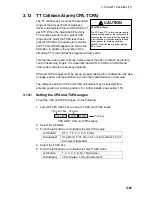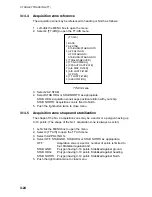
3. TARGET TRACKING (TT)
3-32
3.18
Criteria for Selecting Targets for Tracking
The FURUNO TT video processor detects targets in midst of noise and
discriminates radar echoes on the basis of their size. Target whose echo
measurements are greater than those of the largest ship in range or tangential
extent are usually land and are displayed only as normal radar video. All smaller
ship-sized echoes that are less than this dimension, are further analyzed and
regarded as ships and displayed as small circles superimposed over the video
echo.
When a target is first displayed, it is shown as having zero true speed but
develops a course vector as more information is collected. In accordance with
the International Marine Organization Automatic Radar Plotting Aid (IMO TT)
requirements, an indication of the motion trend should be available within 20
scans of antenna and full vector accuracy within 60 scans. The FURUNO TTs
comply with these requirements.
Acquisition and tracking
A target which is hit by five consecutive radar pulses, is detected as a radar echo.
Manual acquisition is done by designating a detected echo with the trackball.
Automatic acquisition is done in the acquisition areas when a target is detected
5-7 times continuously depending upon the congestion. Tracking is achieved
when the target is clearly distinguishable on the display for 5 out of 10
consecutive scans, whether acquired automatically or manually. Required
tracking facilities are available within 0.1-32 nm on range scales including 3, 6,
12 nm, full plotting information is available within one scan when the range scale
has been changed.
Targets not detected in five consecutive scans become "lost targets."
Quantization
The entire picture is converted to a digital from called "Quantized Video." A
sweep range is divided into small segments and each range element is "1" if
there is radar echo return above a threshold level, or "0" if there is no return.
The digital radar signal is then analyzed by a ship-sized echo discriminator. As
the antenna scans, if there are five consecutive radar pulses with 1’s indicating
an echo presence at the exact same range, a target "start" is initiated. Since
receiver noise is random, it is not three-bang correlated, and it is filtered out and
not classified as an echo.
The same is true of radar interference. Electronic circuits track both the closet
and most distant edges of the echo. At the end of the scanning of the echo, the
discriminator indicates the measured maximum range extent and total angular
extent subtended by the echo. If the echo is larger than a ship-sized echo in
range extent and/or angular width, adjusted as a function of range, it is declared
to be a coastline and the closet edge is put into memory as a map of the area.
















































